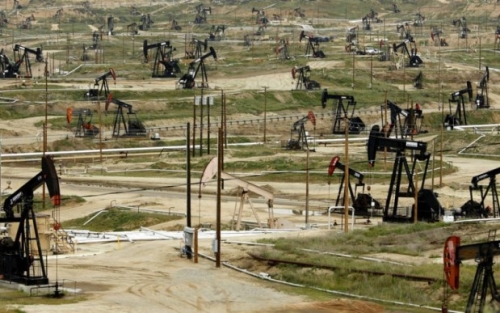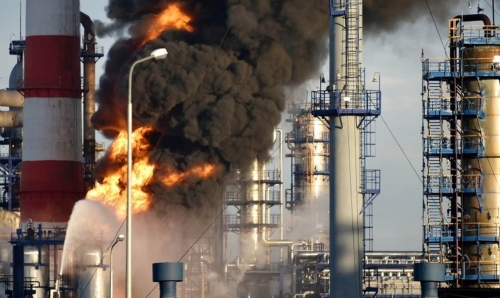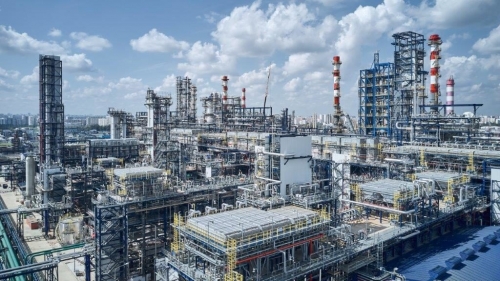Oil benchmarks recorded their first weekly gain in 3 weeks. Oil markets spent most of the week seeking direction with most of the gain recorded on Thursday following new US sanctions on Iranian oil exports. US gas prices declined by nearly 10% this week amid forecasts of milder weather conditions across the country yet remained supported by record-high LNG export operations.
BKR Rig Count | The total active drilling rigs in the United States increased by 2 last week, to 585.Oil rigs increased by 1 to 481, and gas rigs increased by 1 to 98. Rig count in the Permian Basin remained flat at 289 | Apr 17 | BKR NAM Rig Count
US Crude Inventories, excluding those in the Strategic Petroleum Reserve (SPR), increased by 0.5 MMbbl to 442.9 MMbbl (about 6% below the 5y average for this time of year). On the products side, gasoline decreased by 2.0 MMbbl (1% below the 5y average). Distillate fuels decreased by 1.9 MMbbl (11% below the 5y average). Total commercial petroleum inventories decreased by 2.1 MMbbl | Apr 11 | EIA Weekly Report
Oil analysts have raced to slash their forecasts for demand and prices in recent weeks amid the tariff turmoil, highlighting the threat that President Donald Trump’s trade war poses to the global economy. Banks, consultants and agencies have so far cut expectations for consumption this year by 320,000 barrels a day, according to the average of 12 estimates compiled by Bloomberg. The reduction — equal to about a third of oil demand growth in a good year — means that a second-half glut will be bigger than previously thought, and analysts say crude is now pricing in a weaker economy | Apr 17 | Bloomberg
The Trump administration took steps to impose levies on Chinese vessels docking at US ports.Under a plan put forward on Thursday, all Chinese-built and -owned ships docking in the US would be subject to a fee based on the volume of goods carried, on a per-voyage basis, also hitting non-Chinese shipbuilders. A second phase beginning in three years would limit LNG shipments on foreign vessels, with restrictions increasing incrementally over 22 years | Apr 18 | Bloomberg
Chinese refiners are importing record amounts of Canadian crude after slashing purchases of US oil by roughly 90% amid escalating trade tensions.Chinese crude imports soared to an unprecedented 7.3 million barrels in March and are on pace to exceed that figure this month, according to data from Vortexa Ltd. Meanwhile, Chinese imports of US oil have collapsed to 3 million barrels a month from a peak of 29 million in June | Apr 16 | Bloomberg
China will allow coal-fired power plants to be built through at least 2027, according to new guidelines, which also call on generators to ensure they’re able to meet gaps in supply from intermittent renewables.Construction will be allowed in places that lack existing capacity, or the ability to balance electricity supply from wind and solar projects | Apr 14 | Bloomberg
European natural gas resumed gains after China signaled it was open to talks with the US, fueling speculation that the world’s two biggest economies can find a way to avoid a protracted trade war.Benchmark futures jumped as much as 3.6% after falling 1.8% earlier Wednesday | Apr 16 | Bloomberg
The EU is set to unveil a comprehensive plan to end its reliance on Russian oil and gas by 2027. Despite reduced Russian pipeline gas deliveries since 2022, the EU increased imports of Russian LNG last year, with Russia accounting for 19% of the EU's total gas and LNG supply in 2024. The EU may increase LNG purchases from the US, which helped fill the Russian supply gap during the 2022 energy crisis. The US was Europe's third-largest gas supplier last year after Russia and Norway. However, businesses and EU diplomats’ have expressed concerns about potential vulnerabilities from relying on US gas, especially as Trump considers energy a trade negotiation tool | Apr 15 | GlobalData
Brazil’s state-controlled oil producer Petroleo Brasileiro SA is reducing diesel prices for the second time this month after a recent downturn in the global oil market and amid political pressure for price relief at the pump. The Rio de Janeiro-based company will cut its diesel price to distributors by 0.12 reais a liter (0.02 US cents) to 3.43 reais per liter on average, gasoline prices were kept unchanged | Apr 17 | Bloomberg
After two decades of more-or-less continuous decline, coal-fired power is making some gains in the US.After years of being costlier than gas, coal is currently a cheaper power source in parts of the US, prompting some plants to switch.Coal-fired generation in the first quarter jumped 23% from a year earlier, according to Enverus.Output from gas-fired plants will fall by about 7.3 gigawatts this year, while coal generation will rise by 4.6 gigawatts, BNEF estimates. Solar — aided by Biden-era tax credits and falling costs — is set to climb by 6.7 gigawatts | Apr 14 | Bloomberg
Looking ahead
IEA Oil Market Report – April 2025 | Global oil demand growth for 2025 has been revised down by 300 kb/d to 730 kb/d, as escalating trade tensions have negatively impacted the economic outlook. IEA has lowered the economic growth assumptions underpinning the forecast, leading to a 400 kb/d reduction in expected oil demand growth for the remainder of the year. Growth is expected to slow further in 2026, to 690 kb/d, but risks to the forecasts remain rife given the fast-moving macro backdrop. The downgrade comes on the heels of robust oil consumption in 1Q25, up by 1.2 mb/d y-o-y – its strongest rate since 2023. World oil supply rose by 590 kb/d to 103.6 mb/d in March, up 910 kb/d y-o-y, with non-OPEC+ leading both monthly and annual gains. OPEC+ will lift output targets by 411 kb/d in May, but the increase may be substantially lower given overproduction by some countries, including Kazakhstan, the UAE and Iraq. Global supply growth for 2025 has been cut by 260 kb/d to 1.2 mb/d, due to a decrease in US and Venezuelan output. Production in 2026 is set to rise by 960 kb/d, with offshore projects taking the lead. Global oil prices tumbled by around $10/bbl in March and early April as risk sentiment soured in the wake of proliferating US tariffs and mounting recession fears. The decision by some OPEC+ members to accelerate the unwinding of extra voluntary production cuts added to the bearish momentum. The significant drop in oil prices rattled the US shale patch, with firms arguing they need $65/bbl on average to profitably drill new light tight oil wells, according to the latest Dallas Fed Energy Survey. New tariffs may also make it more expensive to buy steel and equipment, further discouraging drilling. Along with the impact of Chinese tariffs on imports of US ethane and LPG, this has resulted in a downward revision of 150 kb/d to IEA’s US oil supply forecast for this year, with growth now assessed at 490 kb/d. However, conventional oil projects remain on track, with total non-OPEC+ supply expected to rise by 1.3 mb/d. Global GDP is estimated around 2.4% for 2025 and 2.5% for 2026, downgraded from 3.1% for both years. GDP has historically been the primary driver of oil consumption, with the two broadly correlating well. In IEA’s models, this combines with an average elasticity of around 0.5 for global oil demand, which aggregates numerous different sensitivities across products and countries. These are typically higher for industrial products such as gasoil, and for developing countries, reflecting the greater oil-intensity of their economies | Apr 15 | IEA
OPEC Monthly Oil Market Review – April 2025 |The global oil demand growth forecast for 2025 is revised down slightly to 1.3 mb/d, y-o-y, mainly due to 1Q25 data and the expected impact given recently announced US tariffs. OECD oil demand is expected to grow by 0.04 mb/d, while non-OECD demand is forecast to expand by almost 1.25 mb/d in 2025, mainly from China, India and Other Asia. 2026 global oil demand growth is revised down slightly to about 1.3 mb/d. The OECD is expected to grow by around 0.1 mb/d, y-o-y, while non-OECD demand is forecast to increase by 1.2 mb/d, y-o-y, in 2026. Non-DoC liquids supply is forecast to grow by about 0.9 mb/d, y-o-y, in 2025, with the US, Canada, Brazil and Argentina as the main growth drivers. Non-DoC liquids supply growth in 2026 also revised down slightly to about 0.9 mb/d, with the US, Brazil, Canada and Argentina as the key drivers. The global economy showed a steady growth trend at the beginning of the year, however, the near-term trajectory is now subject to higher uncertainty given the recent tariff-related dynamics. Consequently, the global economic growth forecasts are revised down slightly to 3.0% for 2025, and to 3.1% for 2026 | Apr 14 | OPEC
EIA Short-Term Energy Outlook – April 2025 | Global oil demand is forecasted to increase by 0.9 mb/d in 2025 and 1.0 mb/d in 2026, revised down by 0.4 mb/d and 0.1 mb/d, respectively, from last month. However, because the recent updates to trade policy widen the range of possible GDP growth outcomes, this forecast is subject to significant uncertainty. EIA’s reduction in liquid fuels demand growth is concentrated in Asia as a result of U.S. tariffs, however EIA continues to see non-OECD Asia as the primary driver of growth. EIA expects India will increase its consumption of liquid fuels by 0.3 mb/d in both 2025 and 2026, (vs. + 0.2 mb/d in 2024), driven by rising demand for transportation fuels, while China will grow by 0.2 mb/d in both 2025 and 2026 (vs. +0.1 mb/d in 2024) as economic stimulus efforts drive higher demand growth. EIA forecasts global liquid fuels production will increase by 1.3 mb/d in 2025 and 1.2 mb/d in 2026, with the scheduled gradual OPEC+ increases and further growth from non- OPEC+ countries. The growth is still expected to be led by non-OPEC+, increasing by 1.2 mb/d in 2025 and by 0.7 mb/d in 2026, driven by the US, Canada, Brazil, and Guyana. Although OPEC+ increases are anticipated to begin in April 2025, EIA expects they will produce below their current target path during most of the next two years to limit increases in global oil inventories and support prices. EIA expects OPEC+ producers will keep crude oil production mostly unchanged this year compared with the 2024 annual average, before increasing production by 0.5 mb/d in 2026. Trade policy assumptions in the STEO are based on S&P Global’s macroeconomic model released mid-March, with assumptions included are partly aligned with the April 2 tariff announcement, assuming a universal tariff rising to 10% by end 2025 and higher rates on US imports from China. EIA used Oxford Economics for the global GDP forecast, which was also completed in mid-March, prior to the most recent tariff announcements | Apr 14 | EIA

%20(1).png)



